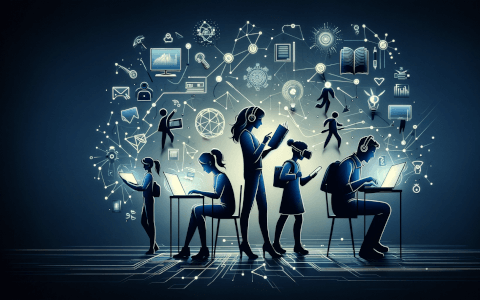You want to learn something new. Maybe you need to figure out how to set up a dashboard in Excel. Now, which one of these learning options sounds more interesting?
- Option A: Reading through a lengthy, written guide that details the steps.
- Option B: Moving through a series of short video lessons and receiving a badge or reward each time you complete a lesson and its corresponding quiz or exercise.
Option B, right? We thought so.
That’s a simple example of gamification in business. But, what is gamification and how can you implement it? We’re answering all of your burning questions in this guide.
What is gamification?
Gamification is when you apply game concepts and elements (like a defined structure or sequence, rewards and prizes, competition, and more) to non-game activities.

How does gamification work?
Now that you have the basics, let’s talk about the mechanics of gamification. Gamification can be applied to digital or in-person initiatives.
Let’s clarify this with a simple example using a popular television show: Parks and Recreation.

If you’re an avid Parks and Rec fan, you might remember an episode where Leslie’s friends are making phone calls to raise money for her city council campaign.
Chris Traeger, one of the show’s most enthusiastic characters, sets up a whiteboard to track how much money each person manages to fundraise. Whoever has the highest total at the end of the night wins a pair of movie tickets.
Believe it or not, that’s an example of gamification. Chris Traeger applied game concepts to a non-game activity. These concepts include:
- Clear objective: What does someone need to achieve to win? In this case, they need to raise the most money for Leslie’s campaign.
- Rules: What guidelines do “players” have to abide by? For example, they shouldn’t lie about donation amounts.
- Reward: What prize will they get if they achieve the objective? They’ll get two free movie tickets.
This activity sparked some friendly competition, which motivated everybody to make more phone calls and solicit more donations.
This sense of going head-to-head with other people — even in a friendly, low-pressure environment — really lights a fire under us.
That’s because we’re hard-wired with something called a “last-place aversion,” which basically means we don’t want to be at the bottom of the pack.
Those are the nuts and bolts of gamification. You’re making things more interesting and engaging by applying even some simple elements of games to everyday tasks and learning activities.
How can gamification benefit your business?
We’ve already briefly touched on the power of gamification, but let’s dig into a few more details. Here are some of the many advantages of gamification in business.
1. Gamification boosts motivation
This ties back to the earlier point about how hard we’re willing to work to avoid last place. As a result, gamification increases motivation.

In fact, one survey found that 89 percent of respondents said that if a task is gamified, they feel eager to complete it and are in a competitive mood. In addition, 62 percent of people say they would feel more motivated if they were given the chance to compete with their peers.
2. Gamification increases retention
Gamification is frequently used in learning activities (which we’ll discuss a little more in the next section).
Not only does this strategy make the content more interesting, but information also sticks with participants for longer. One study found that making work fun increased employees’ skill retention by a whopping 40 percent.
3. Gamification improves engagement
Ask employees if they’d rather sit through a seminar or compete against each other in an educational exercise, and we’re willing to bet almost all of them will choose the latter option.
Needless to say, using gamification increases employee engagement. One study estimates that it can raise engagement levels by as much as 48 percent.
4. Gamification supports teamwork
You might think that pinning colleagues against each other for some friendly competition would breed the exact opposite of teamwork, but that’s not true.

Combine all of that together, and you get to the biggest benefit of all: Gamification can improve your team’s performance at work. If you're curious, here's the story of how the O'Brien Fine Foods team saw massive success with making learning fun and entertaining.
How to use gamification in your business
Get inspired by the success of O’Brien Fine Foods’ training program.
Where is gamification used in business?
Gamification can be used in a number of different places. For example, some companies use it to increase customer loyalty, like how Starbucks enables customers to earn stars through their app and redeem them for different rewards. That’s gamification.
Or, businesses could use gamification with specific teams and departments. FreshDesk implemented gamification for their customer support team, where team members were awarded points for resolving issues promptly, receiving high scores for customer satisfaction, and more.
But, if you want to use gamification more broadly across your organization, let’s look at a few different ways you can do that.
1. Gamification in learning and development
This is an area where gamification is gaining an incredible amount of steam. Statista estimated that the education gamification market value would reach $1.5 billion by 2020.
Companies are using gamification to educate their employees on a variety of different things, including (but certainly not limited to):
- Company procedures
- Refined workflows and processes
- New skills or software
Want to easily use gamification for your team’s learning initiatives? Sign up for GoSkills today to give your team access to bite-sized, gamified online courses.
2. Gamification in team-building
Remember when we said that — as counterintuitive as it sounds — gamification can breed excellent teamwork? It’s true, and it’s why it’s become so popular for team-building.

3. Gamification in employee onboarding
The employee onboarding period is a delicate time, with an estimated 20 percent of employee turnover happening within their first 90 days of employment.
Gamification can help guide new employees through all of those important onboarding tasks — like learning your company’s policies and signing up for their benefits — in a way that’s equally educational and engaging. Basically, no more wading through never-ending piles of boring paperwork.
3 tips for implementing gamification in business
If you’re intrigued by the benefits of gamification and interested in rolling it out for your own team and company, here are a few other things you should know to make it happen.
1. Make the rules, objectives, and expectations clear
About half of employees admit that they don’t know what’s expected of them at work. This means that when you use gamification, you need to explicitly state the ground rules.

Create some sort of cheat sheet or manual for your gamified process so that people have the information they need — before they get started.
2. Be thoughtful about rewards
Rewards are way more motivating if they’re things that people actually want. So, make sure you’re in touch with your team about what rewards would get them most excited.
Do they want free coffee? A team pizza party? The option to take an afternoon off?

There are tons of options you could explore, and your team members will likely have plenty of opinions and ideas about what they’d most want to work toward.
3. Monitor progress
As people move through the gamified process, they should have a clear idea of how they’re progressing — as well as how their competitors are performing.
Look for a learning management system (LMS) that makes it obvious where people stand.
For example, GoSkills users collect coins when they complete certain learning achievements. When they earn more coins, they unlock a status level. It’s a simple way for people to figure out how they stack up against their team members.

Use gamification to unlock your team’s potential
Gamification is fairly straightforward: You apply game elements to various activities and processes within your business. It encourages some friendly competition and makes things a heck of a lot more interesting.
When it’s done well, gamification offers a ton of perks, including increasing motivation, engagement, retention, teamwork, and performance.
Ready to reap these benefits in your company’s learning and development efforts? You’ll need an LMS that supports gamification. Get started with GoSkills today to give your team access to bite-sized, gamified online courses.
A better way to train
It's easier than ever to create, track, and manage team training with the GoSkills LMS.
Start for free



